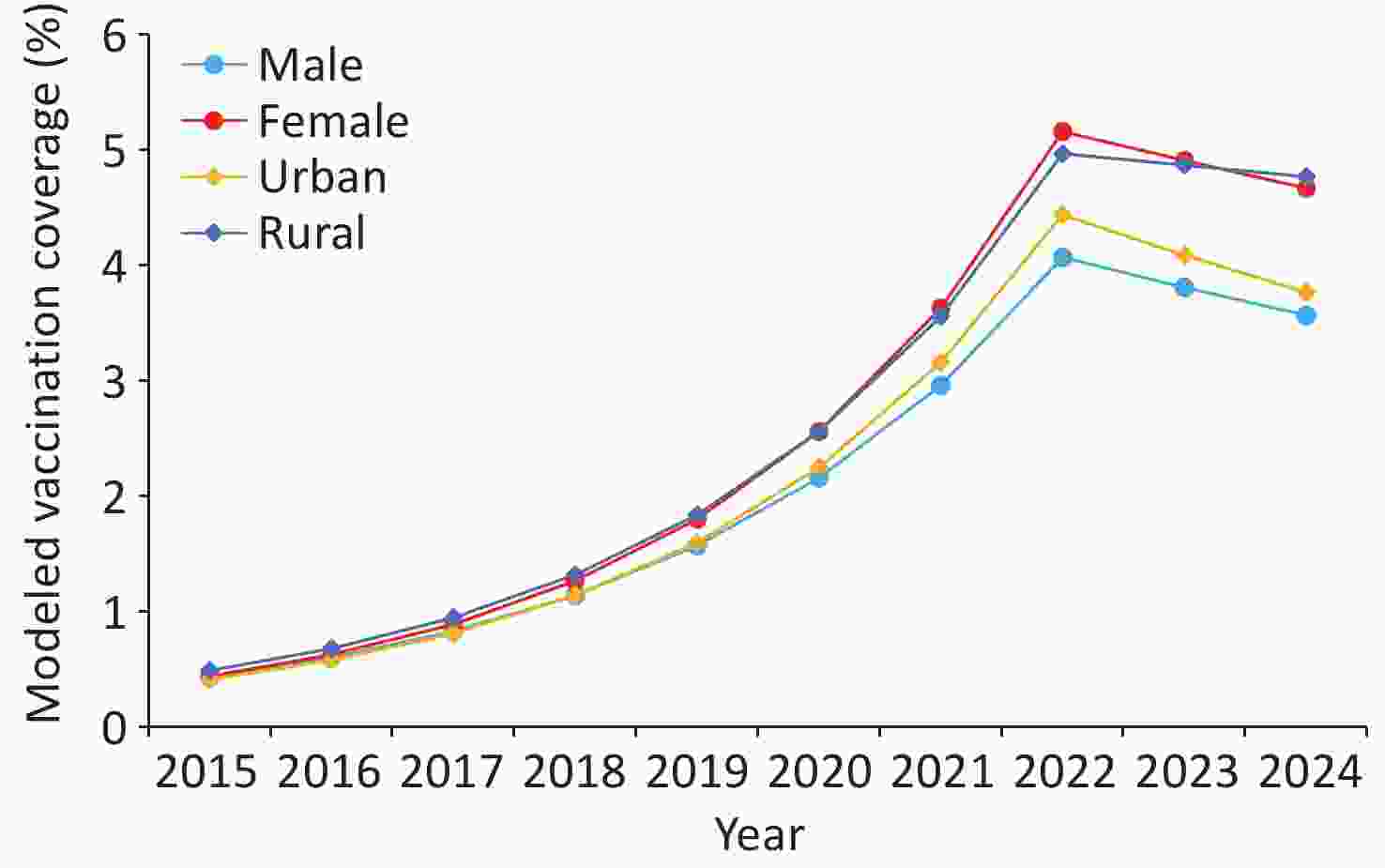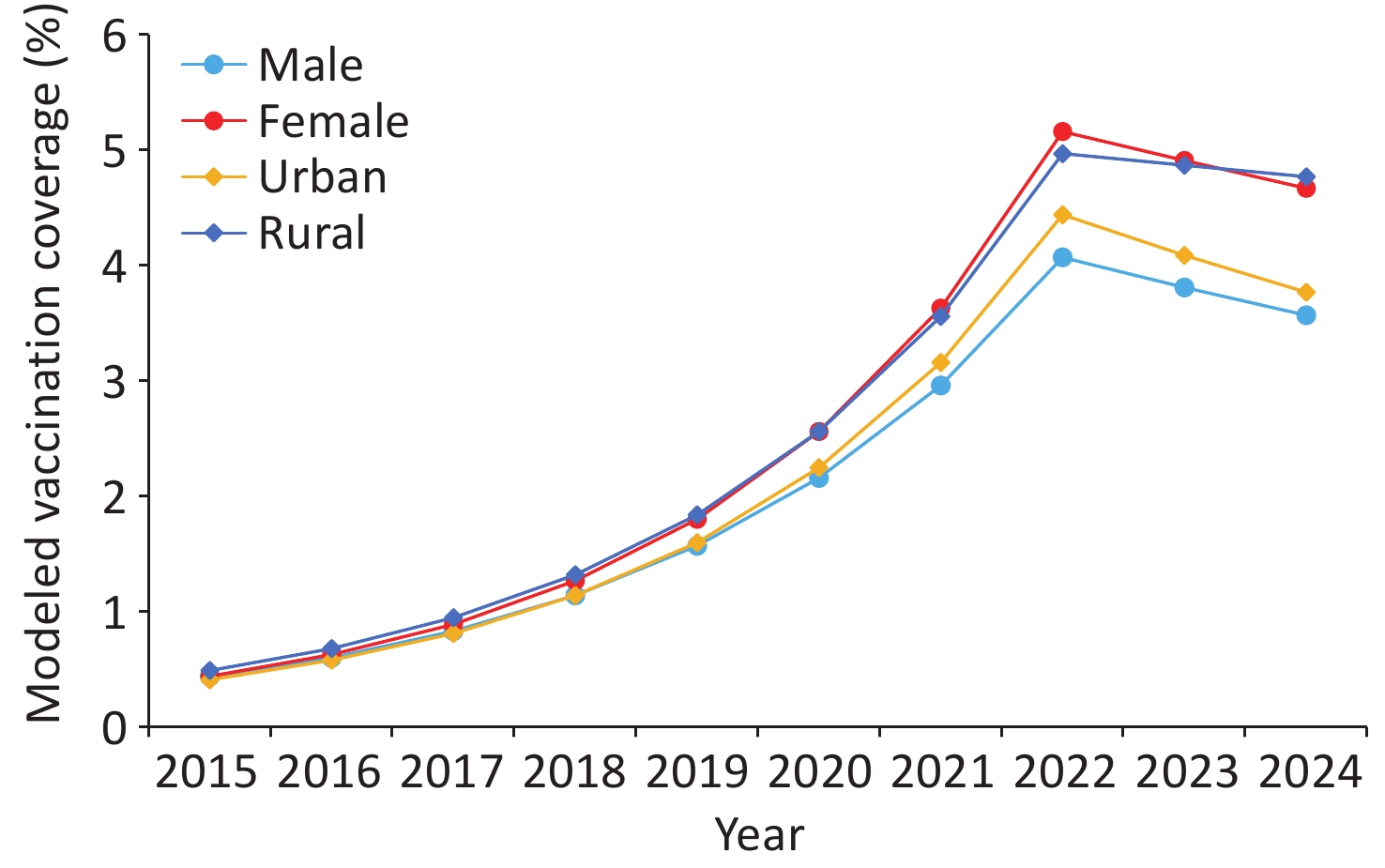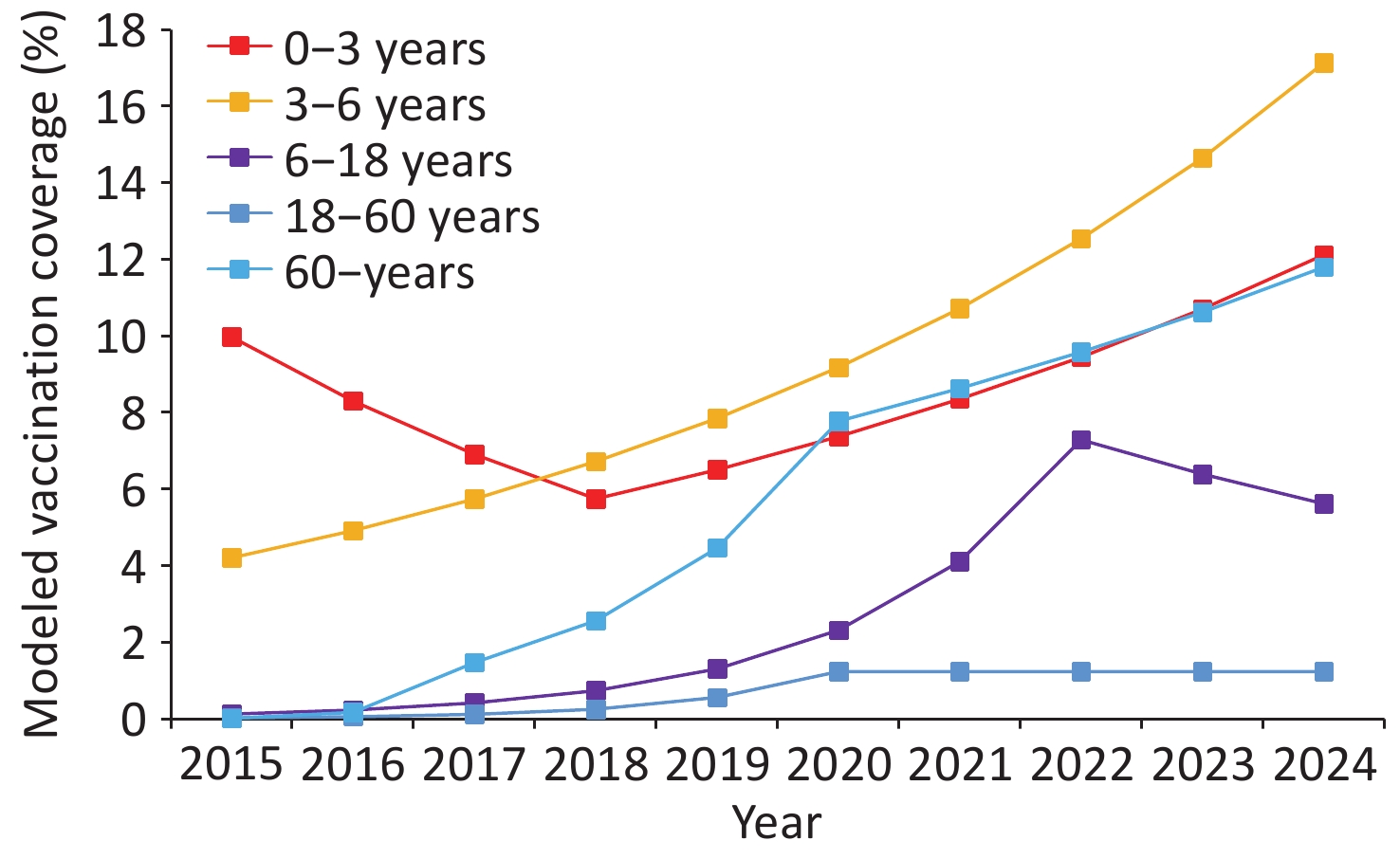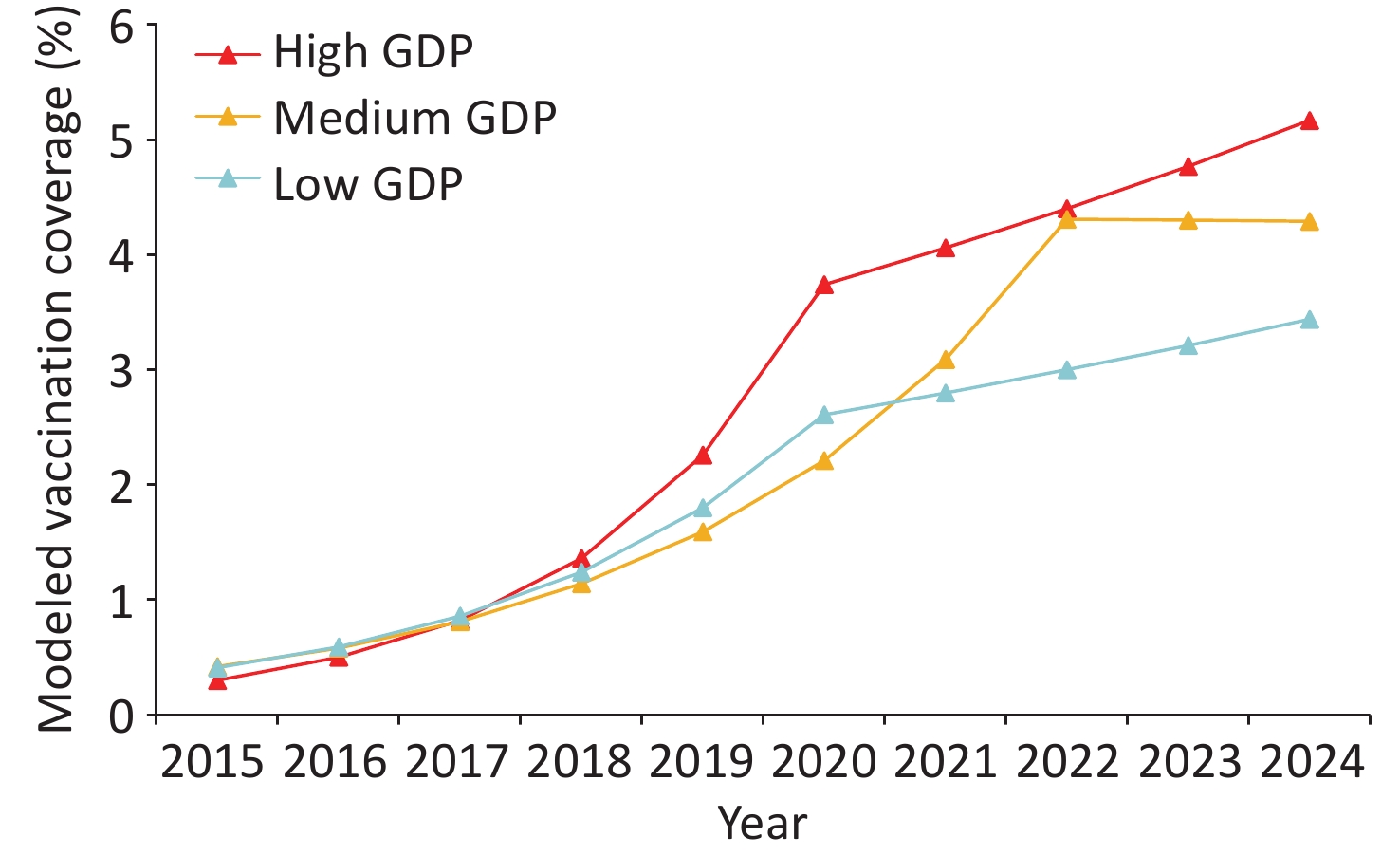-
Influenza is a significant global public health challenge, with seasonal epidemics imposing substantial burdens on healthcare systems and vulnerable populations, causing 3 to 5 million severe cases and 290,000 to 650,000 respiratory-related deaths worldwide each year[1]. Vaccines are an effective means of preventing influenza. In recent years, China has made progress in vaccine development and immunization strategies. The population is recommended to receive influenza vaccines annually; however, their coverage remain suboptimal[2]. The World Health Organization (WHO) highlights that all countries should consider implementing seasonal influenza immunization programs, with priority groups determined based on local epidemiological contexts. In alignment with the Immunization Agenda 2030, the use of seasonal influenza vaccines contributes to strengthening the life course of immunization and serves as a critical component for addressing influenza pandemics, as outlined in the WHO Global Influenza Strategy 2019–2030. Since 2018, the Chinese Center for Disease Control and Prevention has updated and issued the Technical Guidelines for the Prevention and Vaccination of Influenza Vaccines in China before the annual influenza season[3]. This study aimed to comprehensively analyze the temporal trend changes observed in Shandong Province from 2015 to 2024 and provide a reference for the formulation of policies to enhance vaccination.
Registration records of influenza vaccines administered in Shandong Province from 2015 to 2024 were obtained from the Shandong Immunization Information System (IIS)[4], and 23, 470, 116 first-dose influenza vaccinations were administered. The vaccination units are medical institutions engaged in preventive vaccination. The IIS is a registration system that covers all vaccination units in a province. According to legal requirements, vaccination units must use an IIS in a standardized manner, accurately record vaccination information, and achieve information-based management of the entire vaccination process. Population data for each year of the same period were obtained from the Shandong Provincial Statistical Yearbook. According to the influenza vaccination procedure, the population under three years of age should receive two doses of influenza vaccine, and the population aged 3 and above should receive one dose of influenza vaccine. In this study, the annual coverage of the first dose of the influenza vaccine per 100 people was calculated as the number of first doses administered in that year divided by the population in that same study year. In addition to sex and urban-rural distribution, vaccination coverage was divided into 0–3 years, 3–6 years, 6–18 years, 18–60 years, and 60 years age groups, as well as high, medium, and low regions based on the Gross Domestic Product (GDP). Qingdao, Jinan, Yantai, and Weifang are classified as high GDP regions; Linyi, Jining, Zibo, Heze, Dongying, and Dezhou are classified as medium GDP regions; and Weihai, Tai'an, Binzhou, Liaocheng, Rizhao, and Zaozhuang are classified as low GDP regions.
Joinpoint version 5.3.0 was used to analyze the trend in influenza vaccination coverage over time in Shandong Province from 2015 to 2024. The turning point of the change in vaccination coverage was determined, and the annual percentage change (APC), average annual percentage change (AAPC), and 95% confidence intervals (CI) were calculated. When APC > 0 and APC < 0, vaccination coverage showed upward and downward trends during the turning point period, respectively. AAPC represents the overall time trend during the research period, when APC = AAPC, it indicates that the vaccination coverage rate has no turning point and shows a unidirectional increasing or decreasing trend. All statistical tests were two-sided, and P < 0.05 was considered statistically significant.
The annual influenza vaccine coverage rose from 0.42% in 2016 to 4.84% in 2023 (Supplementary Table S1), which is consistent with the country's efforts to expand influenza vaccination, including the annual release of technical guidelines for influenza vaccine prevention and vaccination, and increased publicity on influenza disease prevention and control. Compared with other provinces in China, the coverage observed in Shandong Province was still lower than that reported in research on high-income areas in China; the population coverage was only half of that in Shanghai[5]. Influenza vaccination has increased significantly since 2020, mainly due to the impact of the novel coronavirus infection prevention and control, and people have improved the prevention of respiratory infectious diseases. However, there has been a decline in vaccine coverage over the past two years, which may be mainly due to a decrease in people's attention to influenza diseases in the post-pandemic era, especially for students in compulsory education[6].
The influenza vaccine coverage was higher in females and rural areas than in males and urban areas. Joinpoint regression analysis showed that the coverage of males, females, and urban and rural populations will exhibit a turning point in 2022 (Figure 1). The growth rate of vaccination coverage in females and urban areas from 2015 to 2022 is higher than that in males and rural areas. Moreover, the declining rate of vaccination coverage for males and urban in 2022–2024 is higher than that for females and rural areas. The AAPC in 2015–2024 were 26.21%, 29.96%, 27.99%, and 28.85%, respectively (Supplementary Table S2). Female's higher coverage was related to their gender caregiving roles, as they prioritized vaccinating themselves and their children to take care of and protect them. Consistent with research in Shanghai[5], coverage in rural areas was higher than that in urban areas, mainly because of the larger population base caused by the migration of workers to cities.

Figure 1. Joinpoint regression analysis of influenza vaccination coverage by gender and region in Shandong Province, China, 2015–2024.
The current policy of influenza vaccination mainly favors key populations such as excellent medical personnel, the elderly aged 60 years and above, chronic patients, pregnant women, and children under 6 years old, which also leads to significant differences in coverage among populations (Supplementary Table S1). The highest coverage was found in the 3–6 age group. Coverage rapidly increased in the 3–6 age group and exceeded that in the 0–3 age group, becoming the age group with the highest coverage. The coverage of the 60– age group also increased significantly, but the coverage of the elderly aged 60 years and above was lower than that in Beijing[7], which provided free vaccination for the elderly. The vaccination coverage of the 0–3, 3–6, and > 60 years age groups was higher than that of the other age groups, indicating that the protective effect of influenza vaccines on children and the elderly has been recognized.
Age-specific coverage trends for influenza vaccination are shown in Figure 2. A turning point occurred in 2018 for the 0–3 age group; coverage decreased in 2015–2018 but increased in 2018-2024. No significant turning point was observed in the 3–6 age group, and coverage increased monotonically. A turning point in 2022 marked growth in 2015–2022 followed by a decline in 2022–2024 for the 6–18 age group. The 2020 turning point separated rapid growth in 2015–2020 from stabilization in 2020–2024 for 18–60 age group. The dual turning points in 2017 and 2020 drove extraordinary growth in 2015–2017, 2017–2020, and 2020–2024–60 years. The AAPC for 2015–2024 were 2.19%, 16.89%, 51.57%, 53.79%, and 102.65% for these age groups, respectively (Supplementary Table S3). Primary and secondary schools in the 6–18 age group are currently prone to influenza outbreaks[8], and the 18–60 age group is the main labor force. Therefore, we should seriously improve the vaccine coverage for these groups.

Figure 2. Joinpoint regression analysis of influenza vaccination coverage by age group in Shandong Province, China, 2015–2024.
The vaccination coverage in high-GDP regions has always been better than that in other regions, indicating that economic status remains an important factor affecting influenza vaccination[2,9]. In addition, regions with better economic status have better medical infrastructure, public health investments, and awareness levels. Figure 3 illustrates the economic differences in influenza vaccination coverage trends. High-and Low GDP regions separated the rapid growth in 2015–2020 from the slower progression in 2020–2024 by the turning point in 2020, and the growth rate of the high-GDP region was higher than that of the low-GDP region. The 2022 turning point distinguished the growth in 2015–2022 from the plateau in 2022–2024 in the medium-GDP region. The AAPC in 2015–2024 were 37.27%, 29.52%, and 26.80% for high, medium, and low GDP, respectively (Supplementary Table S4). The sustained growth of coverage in the high-GDP region was attributed to the support of sound economic and fiscal policies, while the growth in the low-GDP region could be attributed to the policy of free vaccination for elderly people aged 60 years and above, such as in Dongying and Zibo city. The pressure on economic development may be greater in regions with a medium GDP; therefore, the trend in vaccination coverage has declined.

Figure 3. Joinpoint regression analysis of influenza vaccination coverage by economic status in Shandong Province, China, 2015–2024. GDP, Gross Domestic Product.
The research findings emphasize the need to develop tailored strategies, such as expanding vaccination programs for primary and secondary school students, maintaining growth trends for children and the elderly, addressing gender and urban disparities, and allocating resources to low economic regions. Continuous investment in lifecycle immunity and pandemic prevention is crucial to achieve universal coverage of influenza vaccines.
Trends Analysis on Vaccination Coverage of Influenza in Shandong Province, China
doi: 10.3967/bes2025.063
- Received Date: 2025-03-04
- Accepted Date: 2025-04-27
The authors declare no competing interests.
No ethical approval was required as no individual data were used in this study.
| Citation: | Guijie Luan, Liang Sun, Weiyan Zhang, Yao Liu, Shaonan Liu. Trends Analysis on Vaccination Coverage of Influenza in Shandong Province, China[J]. Biomedical and Environmental Sciences. doi: 10.3967/bes2025.063 |








 Quick Links
Quick Links
 DownLoad:
DownLoad:

